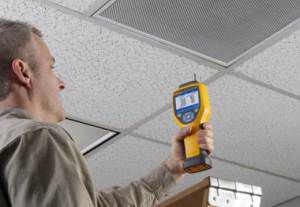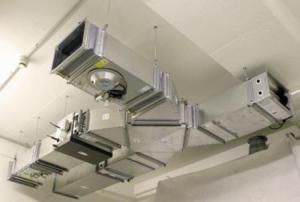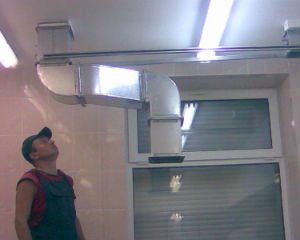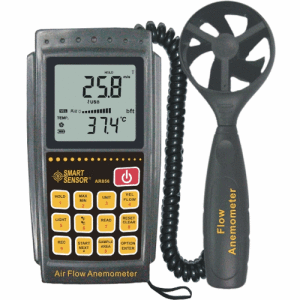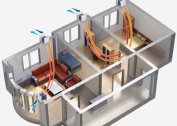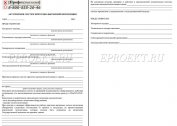Production control or checking the efficiency of the ventilation system is one of the main conditions for the proper use of equipment. The need for checks of the effectiveness of ventilation systems is provided by GOST 12.4.021-75 and SNiP 3.05.01-85. Inspections and inspections of equipment are carried out according to a schedule compiled by the administration of the enterprise. Daily routine inspections of equipment are carried out with recording the results in a journal.
The need for ventilation checks
It is often difficult to discover on your own that ventilation is ineffective. The equipment may work, but it is not possible to draw out exhaust air weakly or vice versa to supply fresh fresh. Residents of modern homes equipped with central air conditioning and ventilation systems may complain of poor health, insomnia, and headaches. The cause of the ailment is sometimes hidden in the insufficiently efficient operation of the ventilation system.
At industrial facilities, dust, toxic or fetid fumes, heat are released into the air. Therefore, the most important is the efficient operation of the ventilation system in production facilities. Poor removal of harmful emissions from the workplace can lead to personal injuries, the development of occupational diseases and even death. Visual methods for checking ventilation are usually not effective enough.
It is necessary to check the effectiveness of the ventilation system before the audit of the sanitary and epidemiological authorities.
Purpose of ventilation check
During the ventilation system performance checks, malfunctions are detected that could lead to industrial accidents or other undesirable situations. The check shows whether the ventilation efficiency was calculated correctly at the design stage, whether the equipment is able to cope with the load and gives the necessary draft.
The main goal of measuring the efficiency of ventilation systems is to determine air flow and pressure losses in the system and mines.
Industrial ventilation systems are a complex combination of high-precision electronics and mechanics, consisting of dozens of elements. Without specialists, it is impossible to evaluate the effectiveness of ventilation.
Checking the effectiveness of the ventilation system is carried out by a licensed inspection. From the customer organization, there is one system maintenance specialist who is well acquainted with its design and the locations of the main nodes. If the enterprise has more than ten air handling units, the help of an electrician is also required. On the basis of the data, the certificate of malfunctions and tables of the air exchange rate in production shops are filled out. Some laboratories offer an immediate estimate of troubleshooting and increasing the efficiency of the ventilation system.
Frequency of ventilation check
Instrumental verification of the effectiveness of ventilation systems and mines is carried out:
- in rooms with the release of combustible, explosive, radioactive or toxic substances of I-II classes - 1 time in 30 days;
- in rooms with supply and exhaust systems - 1 time in 12 months;
- in rooms with a natural or mechanical general exchange system - 1 time in 36 months.
Testing the effectiveness of ventilation systems is a combination of instrumental and laboratory measurements.
Checking the effectiveness of ventilation is carried out by the measurement method:
- air velocity in ventilation ducts and ducts;
- air exchange rates (calculated)
Measurement indicators can be either increased or decreased, and in both cases they indicate insufficient ventilation.
A set of verification measures:
- Checking the natural ventilation system. It is carried out during the commissioning of the building. The results are entered into the act of initial examination;
- Checking the artificial ventilation system. The condition and performance of all components of the supply, mixed or exhaust ventilation are checked. Data is entered into the protocol of laboratory measurements. The client receives a ventilation passport and a conclusion on compliance or non-compliance with design standards.
Most often, the energy efficiency of a ventilation system is checked in two stages. At the first stage, the most noticeable shortcomings are found:
- damage to flexible elements;
- leaks in housings and ducts;
- insufficient number of drive belts;
- imbalance of fans.
All deficiencies are recorded in the defect list. After the correction of which the second part is carried out: instrumental verification of the ventilation system performance.
In some cases (if the client cannot eliminate the shortcomings in a short time), the verification is carried out in one step. Then all defects are recorded directly in the measurement protocol of the ventilation system operation efficiency.
Work
To assess the effectiveness of the ventilation system, the following measurements are carried out:
- Microclimate parameters in rooms served by ventilation. Measured carbon dioxide levels in the work area and outside;
- The composition of the air. This indicator is usually measured at industrial enterprises; aerosol and gas analyzes of the composition of air in workrooms are carried out;
- Aerodynamic tests. They are carried out according to the method of GOST 12.3.018-79.
Measurements of the efficiency of the ventilation system are carried out through pneumometric openings located along the most probable axis of symmetry of the air flow in the branches of the air ducts. If the places for measurements are not determined correctly, the error in the calculations increases, making them useless.
To determine the parameters of the air environment, air samples are taken during working hours, at the locations of personnel. Sometimes up to 5 samples are taken at each sampling point. Samples are taken using aspirators or traction agents.
The following equipment is required to carry out an instrumental check of the ventilation system operation efficiency:
- roulette;
- Lantern;
- thermometer;
- micromanometer or differential pressure gauge;
- pneumometric tubes;
- funnel anemometers;
- tachometer.
All the results of an instrumental check of the ventilation system operation efficiency are entered in the summary table. Many companies immediately make an electronic version of the act, since the calculation of ventilation efficiency is carried out by a computer using special programs. You can call them and they will tell you specifically how to check the ventilation in the apartment or house yourself.
Instrumentless ventilation control
Sometimes in practice, verification of ventilation efficiency is carried out by the non-instrument method.
The operation of the exhaust fans is checked with a piece of paper. If it is held on the ventilation grill, there is draft. But this is not an objective way. The sheet at the outlet of the channel is not held by air movement, but by the pressure difference in the room and in the ventilation duct, sometimes created by gravitational pressure.
Therefore, it is really possible to notice the effect of the exhaust ventilation operation by checking with smoke. A cigarette is lit under the exhaust hole. If smoke is directed to the grill, ventilation works satisfactorily. Otherwise, the entire room is gradually filled with smoke.Conducting a check of the ventilation efficiency by the method described above is rather approximate. Its results are not recorded in writing and are not used to calculate ventilation efficiency.
Ventilation performance
The energy efficiency indicator of ventilation is called the air exchange coefficient.
The energy efficiency of ventilation is calculated by the formula:
K = (Tu-Tpr) \ (Toz-Tpr),
Where TO- ventilation energy efficiency coefficient,Tu - temperature of the removed air outside the service area, in degrees Celsius,TPR - supply air temperature,Toz - air temperature in the served area.
See why the video shows why ventilation efficiency can drop significantly.
